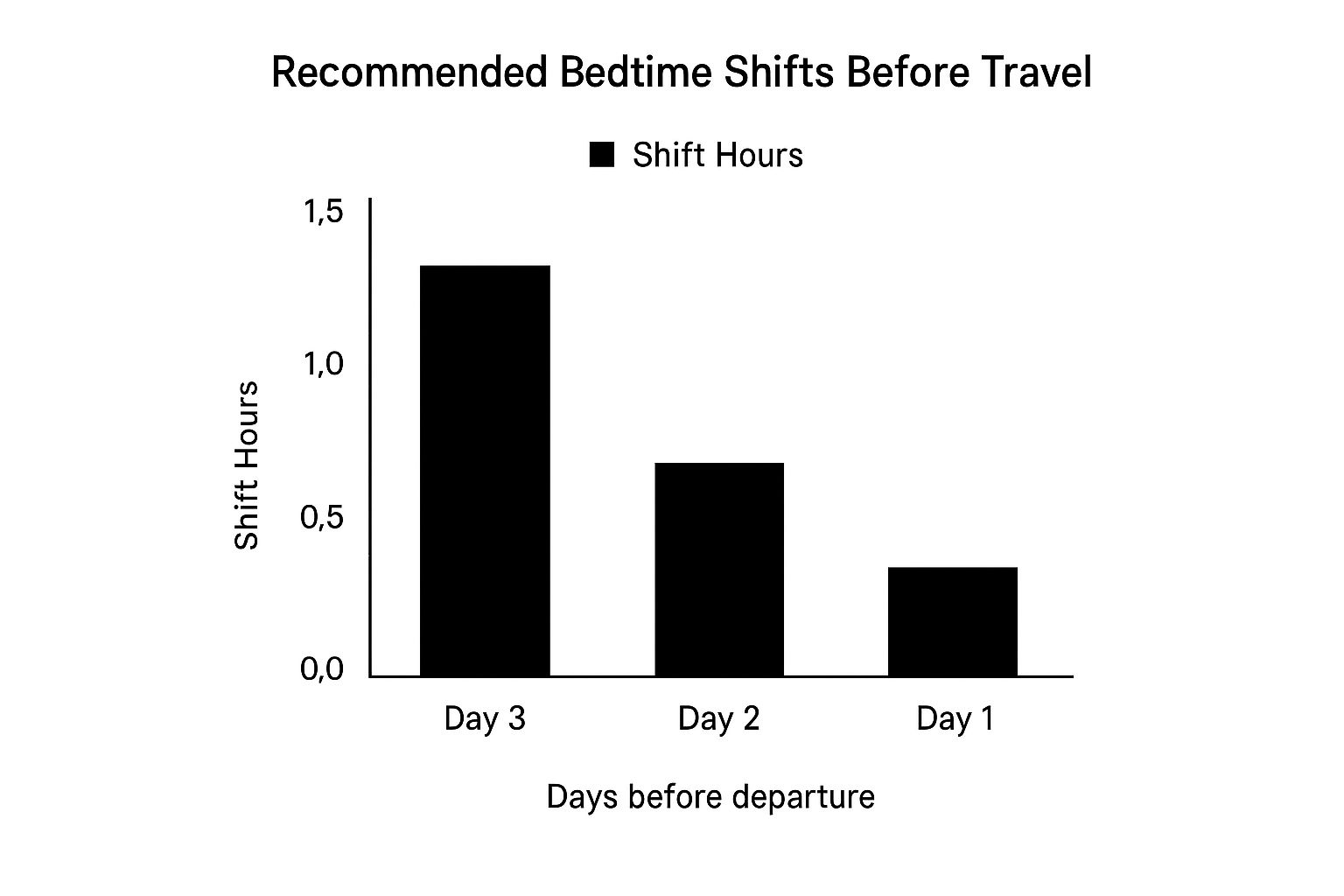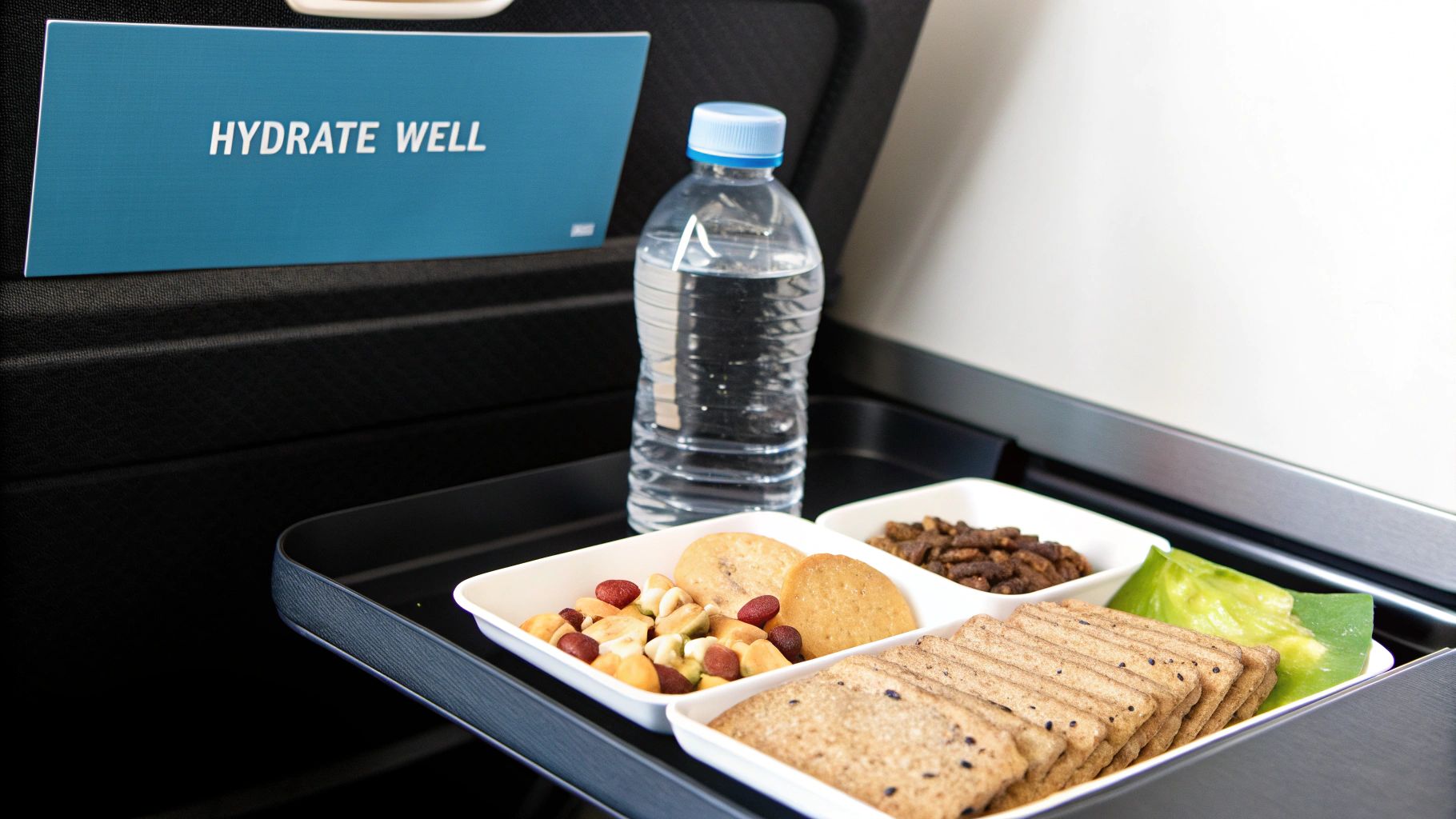Why Your Body Wages War Against Time Zones

That utterly drained feeling after a long-haul flight? It’s more than just plain old tiredness. Think of it as your internal clock, your circadian rhythm, throwing a major tantrum over the sudden time change. I’ve chatted with flight attendants who practically live in different time zones, and seasoned travelers who’ve circled the globe countless times. The consensus? Jet lag is a full-body revolt. It messes with your appetite, your sleep, and even your ability to think straight.
Understanding the Circadian Rhythm Disruption
This internal clock isn’t just about sleep. It’s the maestro conducting a whole orchestra of bodily functions, from your sleep-wake cycle and hormone release, right down to your body temperature. Hop across a few time zones quickly, and this carefully orchestrated system goes haywire. It’s like suddenly telling yourself your workday starts five hours earlier, no warning whatsoever. Your body is anticipating one thing, but the world around you is singing a completely different tune. Cue the classic jet lag symptoms: exhaustion, sleepless nights, tummy troubles, and that overall “blah” feeling.
There’s a reason why some people feel completely incapacitated and some have it easy. It’s about their chronotype and how they deal with sleep. There are many elements to consider, some genetic.
Why Flying East Feels Worse
Ever noticed that eastward flights seem to hit you harder? There’s a scientific reason behind it. Eastward travel effectively shortens your day, something our bodies struggle with far more than lengthening it. It’s like trying to squeeze an extra meeting into an already jam-packed day. Imagine touching down in London from New York. Your body’s still on New York time, but the sun’s setting way earlier than it “should” be. This makes it tough to fall asleep at the local time, which just feeds the jet lag monster. Westward travel, while still disruptive, gives your body a little extra time each day to adjust, almost like a bonus hour.
Individual Factors and Recovery
While the core mechanics of jet lag are universal, recovery time is definitely not. Your age, your sleep habits, even your chronotype (are you a morning lark or a night owl?) all come into play. Some people bounce back in a day or two, while others feel the aftershocks for a week. This means your best defense against jet lag is a personalized strategy. There are elements you can control, from tweaking your sleep schedule before you leave to managing light exposure when you arrive. Addressing these factors can seriously minimize the severity of your jet lag and get you back in the game much faster. We’ll dive into these personalized strategies in the next sections.
Mastering Light Exposure Like a Pro Traveler

The infographic above shows how shifting your bedtime in the days before you fly can really help. Even nudging your sleep schedule by just 0.5 to 1.5 hours each night makes a difference. Think of it as prepping your body for the time zone shift. It’s like a warm-up for your internal clock.
Most people think any sunlight is good for jet lag. Not true! I learned this directly from pilots – the ultimate time-zone hopping pros. The key isn’t just getting light, it’s about the timing. For example, early morning sun can actually make jet lag worse if you’re flying east.
Harnessing the Power of Light
I’ve picked up some great tips from travel bloggers who regularly fly brutal routes like New York to Bangkok. One of their secrets? Light therapy glasses. These aren’t just a fad; they can mimic daylight during those long layovers, helping your body adjust quicker. There are also some handy smartphone apps that can calculate the best times for light exposure based on your flight. They’ll tell you when to seek the sun and when to hide from it.
One of the most effective jet lag strategies revolves around light exposure. Light is the most powerful signal for your body’s natural clock. When flying east, avoid bright light for a few hours after landing, then get some sun after 11 a.m. This helps shift your internal clock forward. Want to learn more about light and jet lag? Check out this resource: https://www.sleepfoundation.org/travel-and-sleep/jet-lag
To help you visualize this, I’ve put together a handy table:
Light Exposure Schedule by Travel Direction
Optimal timing for light exposure and avoidance based on whether you’re traveling east or west
| Travel Direction | Before Departure | During Flight | Upon Arrival | First 2 Days |
|---|---|---|---|---|
| East | Start shifting bedtime earlier by 0.5-1.5 hours each night | Keep cabin lights dim; try to sleep during the “night” hours of your destination | Avoid bright light for several hours; seek light after 11 a.m. | Seek morning light; avoid light in the evening |
| West | Start shifting bedtime later by 0.5-1.5 hours each night | Keep cabin lights on; avoid sleeping until the “night” hours of your destination | Seek bright light upon arrival, especially in the afternoon/evening | Seek light in the afternoon/evening; avoid light in the morning |
This table simplifies light exposure strategies for different travel directions. Remember, adjusting your sleep schedule before you leave, combined with smart light management during and after your flight, can significantly reduce jet lag.
Avoiding Light at the Right Times
Avoiding light is just as important as getting it, especially right after you land. Imagine your body’s clock as a delicate instrument. Sudden light changes are like playing a wrong note. By strategically avoiding light, you allow your body to smoothly adapt to the new time zone. This can be a game-changer for how quickly you adjust to your new surroundings. Planning your accommodation around light exposure can also be helpful. For tips on choosing the right spot, check out this guide on Where to Stay in Tokyo as a Solo Traveler.
Sleep Adjustments That Won’t Sabotage Your Trip

Let’s be honest, that old advice about staying awake all day after landing? Terrible. Miserable. And it rarely works. Trust me, I’ve been there, and so have many other seasoned travelers. We’ve all learned that lesson the hard way. The real secret to beating jet lag isn’t about white-knuckling it through exhaustion, but about making smart adjustments before you even depart. And the best part? These pre-trip tweaks won’t disrupt your whole week.
Shifting Your Sleep Schedule Gradually
Over the years, through my own travels and countless conversations with frequent flyers, I’ve picked up some seriously valuable in-flight sleep strategies. It’s not just about popping a melatonin and hoping for the best. Little things like choosing the right seat, setting up a comfy sleep environment on the plane, and being strategic about when you sleep during the flight can dramatically impact how you feel when you land. For extra tips on getting quality sleep once you’re at your destination, check out our guide: How to Get Better Sleep When You Travel.
Think of your sleep schedule like a rubber band, not a stiff board. You can stretch it a bit without snapping it. Start adjusting your bedtime by 30 to 90 minutes each day leading up to your trip. Shift it earlier if you’re flying east, later if you’re going west. This gradual approach is much gentler than trying to shock your system with a massive shift all at once.
In-Flight Sleep Strategies
Once you’re on the plane, your in-flight sleep sanctuary is crucial. A decent neck pillow, a good eye mask, and some earplugs can be game-changers. Think carefully about your seat, too. A window seat lets you lean, but an aisle seat gives you easy access to the bathroom and chances to stretch. Figure out what works best for your sleep.
Timing your sleep is just as important as being able to sleep. Try to sync your sleep with your destination’s time zone. If it’s nighttime there, try to get some shut-eye, even if you’re not tired. If it’s daytime at your destination, resist napping, even if you’re exhausted. This helps soften the blow to your system when you arrive.
Managing Those First Few Nights
Those initial nights in a new time zone can be rough. If you’re struggling to stay awake, a quick 20-30 minute nap can help, but avoid long naps, especially later in the day, as they can mess with your nighttime sleep. Getting sunlight at the right times (we talked about this in the last section) is also key to resetting your internal clock. Think of it as fine-tuning your body to your new surroundings. By combining these strategies, you’ll significantly improve your sleep during those first few nights and make the time zone transition much smoother.
Smart Supplements and Natural Recovery Methods
Melatonin is the go-to jet lag remedy everyone talks about, right? But trust me, there’s a whole other world of supplements and natural techniques that can make a huge difference. From my own travels and chats with fellow globetrotters, I’ve learned that timing and dosage are everything. Sometimes, less is definitely more.
Melatonin and Beyond
Melatonin has been studied extensively for jet lag, and for good reason. When you’re traveling east, taking it in the evening can help shift your internal clock forward, making it easier to fall asleep at your new local time. Even small doses, like 0.5 milligrams, can be surprisingly effective. Studies show roughly 70% of travelers find it helpful. Want to learn more about melatonin and jet lag? Check out this helpful resource from the Mayo Clinic.
Beyond melatonin, seasoned travelers often swear by other options like magnesium and valerian root. Magnesium can help relax your muscles and improve sleep quality, while valerian root has mild sedative properties.
Natural Techniques
Pills aren’t the only answer. Targeted breathing exercises can work wonders for regulating your nervous system and easing travel stress, making it easier to adapt to a new time zone. Even in a hotel room, aromatherapy can be a game-changer. Try lavender essential oil to create a calming atmosphere before bed.
If you, like me, sometimes struggle to unwind in the evenings, even at home, check out these tips for creating a relaxing Sunday night routine: 7 Essential Steps to Create the Perfect Sunday Night Routine for a Productive Week. Adapting these principles on the road can help establish a sense of normalcy and improve your sleep.
What to Avoid
Knowing what not to do is just as important. Certain supplements and habits can actually make jet lag worse. Avoid excessive caffeine and alcohol, especially close to bedtime. That glass of wine might seem tempting, but it can disrupt your sleep and intensify jet lag symptoms. Similarly, too much caffeine can leave you wired and interfere with your body’s natural adjustment process. Looking for ways to generally improve your sleep? Here are some helpful tips on how to sleep better.
Finding the Right Approach
Everyone’s different. What works for one person might not work for another. Start with small doses of any supplement and pay attention to how your body responds. Combine supplements with natural methods like deep breathing and aromatherapy for a holistic approach. The key is to listen to your body and adjust your strategy as needed. The goal is to find a sustainable routine that helps you minimize jet lag’s effects and truly enjoy your travels.
Eating and Hydration Tactics for Faster Recovery

Let’s talk jet lag recovery, and specifically, how what you eat and drink can make a huge difference. I learned this trick from a flight attendant friend who’s constantly zipping across time zones, yet rarely looks jet lagged. Her secret isn’t some fancy detox, it’s all about meal timing and smart hydration.
Timing Your Meals for Optimal Adjustment
Think of your meals as little “reset” buttons for your body clock. Eating at the right times in your new time zone is like hitting that reset button at just the right moment.
Let’s say you land in Amsterdam early in the morning. Even if your stomach’s saying “it’s still bedtime,” try to have a local breakfast. It’s a powerful signal to your body that it’s morning in Amsterdam. While you’re at it, get out and explore! Check out our guide on how to get around Amsterdam and keep yourself busy. Staying active helps with the adjustment too.
Conversely, skipping meals or eating at odd hours can throw your internal clock even further out of whack, prolonging your jet lag misery. Stick to regular mealtimes in your new zone, and you’ll be back to normal much faster.
Smart Hydration Strategies
Hydration is crucial for jet lag recovery, but not all drinks are created equal. Water is your best friend, no doubt, but consider adding electrolyte drinks to the mix. Travel can deplete your electrolytes, and these drinks help replenish them, fighting fatigue and boosting your well-being.
On the flip side, sugary drinks and too much caffeine, especially close to bedtime, are your enemies. They can dehydrate you and disrupt your sleep, making jet lag even worse. Instead, reach for herbal teas or decaffeinated drinks to relax and hydrate. Looking for a little extra help with sleep? Natural sleep aids can be a great option too.
Pre-Flight, In-Flight, and Post-Flight Food Choices
Planning your meals strategically before, during, and after your flight can also significantly impact how quickly you bounce back from jet lag.
- Before: Focus on light, easily digestible meals.
- During: Airplane food can be a challenge, but try to choose lower-sodium, nutrient-rich options. Packing some healthy snacks like fruit or nuts is always a good idea.
- After: Once you arrive, eat at regular mealtimes in your new time zone, even if you aren’t ravenous. This helps reset your internal clock and minimize those pesky jet lag symptoms.
To help illustrate the various approaches you can take, I’ve put together a comparison table highlighting the effectiveness, ease of use, and cost of different jet lag prevention strategies. It also suggests which method might be best for different travel situations.
Jet Lag Prevention Methods Comparison
| Method | Effectiveness Rating | Ease of Use | Cost | Best For |
|---|---|---|---|---|
| Meal Timing | High | Medium | Low | All travelers |
| Hydration with Electrolytes | Medium | High | Low | Long flights, active travelers |
| Avoiding Sugary Drinks/Caffeine | Medium | High | Low | All travelers, especially those sensitive to caffeine |
| Natural Sleep Aids | Medium | High | Low to Medium | Travelers struggling with sleep |
| Light Exposure Therapy | High | Medium | Medium (if purchasing a device) | Long flights, significant time changes |
As you can see, even simple strategies like adjusting your mealtimes and being mindful of your hydration can have a powerful impact on how quickly you adjust to a new time zone. By incorporating these tips into your travel routine, you can minimize jet lag and maximize your enjoyment of your trip.
Building Your Personal Anti-Jet Lag Game Plan
Let’s be honest, cookie-cutter jet lag advice just doesn’t cut it. A quick hop across the pond is totally different from a month-long backpacking trip, and your jet lag strategy should reflect that. You can’t always shift your sleep two weeks in advance, and that’s okay!
Tailoring Your Strategy to Your Trip
Whether you’re popping over to London for a long weekend or trekking through Southeast Asia for a few weeks, I’ll help you build a realistic plan. We’ll ditch the rigid schedules and focus on practical adjustments you can actually make.
Think of a quick flight from New York to London. That five-hour time difference? Shifting your bedtime just an hour earlier for three or four nights before you go can make a noticeable difference. Now, compare that to a longer haul, like New York to Bangkok – a whopping 12-hour shift. For that, starting your adjustments a week out is ideal.
For my fellow solo female travelers, safety is always paramount. A great resource I’ve found helpful is Travel Tips for Solo Women Travelers. It’s packed with practical advice for navigating new places with confidence.
Adapting to Different Scenarios
Traveling with kids? Forget drastic changes. Small, gradual shifts to their bedtime and mealtimes in the days leading up to your trip can work wonders. If you’re on a business trip with back-to-back meetings, strategic power naps and light therapy glasses can be your secret weapon for staying sharp.
And, of course, if you have any health conditions that impact your sleep, chatting with your doctor before changing your routine or trying supplements is essential. They can provide the best personalized advice.
Troubleshooting and Realistic Expectations
Travel rarely goes exactly as planned. Missed connections, unexpected delays – they happen. Let’s say your carefully planned sleep schedule gets thrown off by a missed flight. Don’t stress! Just reassess and adjust based on your new arrival time. Flexibility is key.
Finally, let’s talk about being realistic. Your age, overall health, and how often you travel internationally all play a role in how quickly you recover from jet lag. A 20-year-old might bounce back faster than someone over 50, and if you rarely travel across time zones, expect it to take a bit longer to adjust. Setting realistic expectations helps you manage any jet lag frustrations and enjoy your trip. Remember, each journey is a learning experience. The more you travel, the better you’ll understand what works best for you and how to conquer that pesky jet lag.
Key Takeaways
Look, jet lag is a beast. But it’s a beast you can absolutely tame. These aren’t theoretical tips; they’re battle-tested strategies from seasoned travelers – folks who’ve been there, done that, and brought back the t-shirt. Think of this as your practical, no-nonsense guide, packed with quick tips for different travel scenarios, red flags to watch out for, and realistic timelines for feeling human again. We’re talking about real-life, workable advice, with backup plans for when things inevitably go sideways (because, travel, right?). For a deep dive on adjusting to new time zones, this article is gold: Best Way To Avoid Jet Lag In 2025 Top Tips For Quick Adjustment
Light Exposure is Your Secret Weapon
Seriously, light is everything when it comes to resetting your internal clock. But timing is key. That morning sun everyone raves about? It can actually make jet lag worse if you’re flying east. Light therapy glasses can be a lifesaver during long layovers, and there are apps that’ll calculate optimal light exposure times for you – super helpful.
- Key Action: When you arrive, avoid bright light for a few hours after an eastward flight, then soak it up. Flip that script for westward travel.
- Warning Sign: Still dragging yourself around after a few days? Your light exposure timing might be the culprit.
- Timeline for Improvement: You should notice a difference within 1-2 days if you’re managing light properly.
Gradual Sleep Adjustments are Key
Forget that whole “stay awake for 24 hours” thing. It’s brutal, and it usually backfires. A much better approach is to gradually shift your sleep schedule by 30-90 minutes each day in the days leading up to your trip.
- Key Action: Move bedtime earlier for eastward trips, later for westward.
- Warning Sign: Tossing and turning at your destination? Your pre-trip adjustments might not have been enough.
- Timeline for Improvement: You should start sleeping better within 2-3 nights.
Food and Hydration Play a Big Role
Meal timing? Just as crucial as light exposure. Eat at regular mealtimes in your new time zone, even if you’re not feeling it. Hydrate like a champ – water and electrolytes are your friends. And try to ease up on the caffeine and alcohol. They’ll mess you up.
- Key Action: Force yourself to eat breakfast at local time, even if it feels ridiculously early.
- Warning Sign: Upset stomach or just feeling constantly wiped out? Your eating and hydration habits might be to blame.
- Timeline for Improvement: Your digestion and energy levels should improve within 1-2 days.
Personalize Your Approach and Be Flexible
Remember, everyone’s different. Your age, how often you travel, your overall health – it all affects how quickly you recover. Don’t be afraid to adjust your plan mid-trip. Flights get delayed, things happen. Just recalibrate and keep moving forward.
- Key Action: Make a realistic pre-trip plan, but be ready to ditch it if you need to.
- Warning Sign: Feeling stressed and defeated? Your plan might be too rigid. Simplify it. Focus on the basics.
- Timeline for Improvement: The more you travel and adapt, the easier it gets. Every trip is a learning experience.
By focusing on these strategies, you’ll go from barely surviving jet lag to actually enjoying your trip from the moment you land.

Hi there! My name is Jenny, and I’m a travel writer who is endlessly curious about the world and always on the hunt for the next best-kept travel secret. My expertise lies in creating destination guides that enable you to travel smarter and especially if you travel solo.
My bylines have appeared on blogs, travel sites, and content agencies, and I’m always ready for the next adventure (and next great caffeine fix). In between assignments, you can find me trawling through a bazaar, sampling street food, or getting lost in an unfamiliar metropolis by choice.

